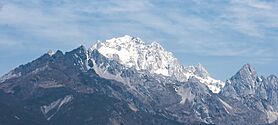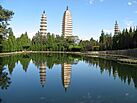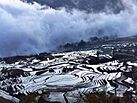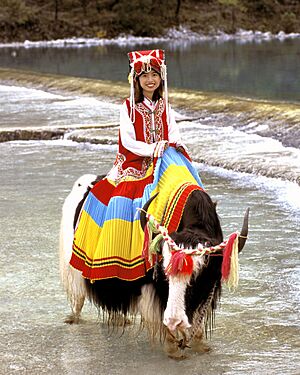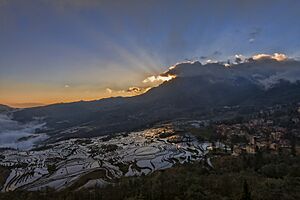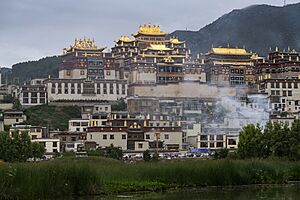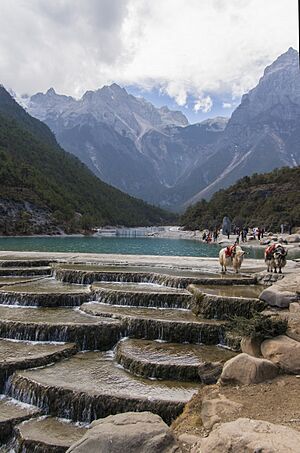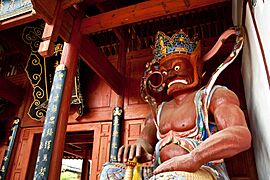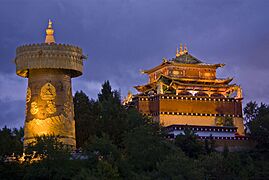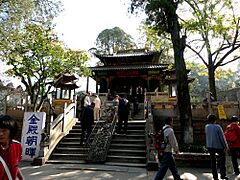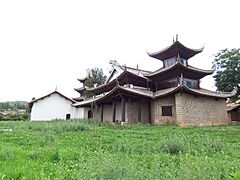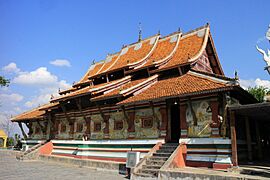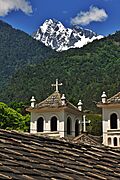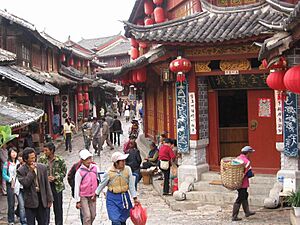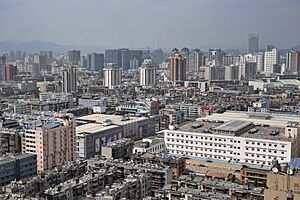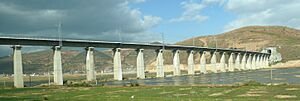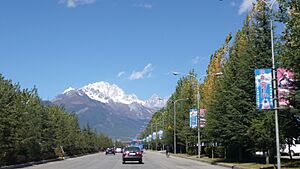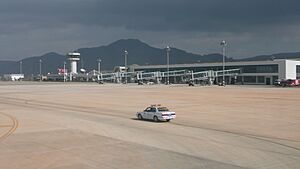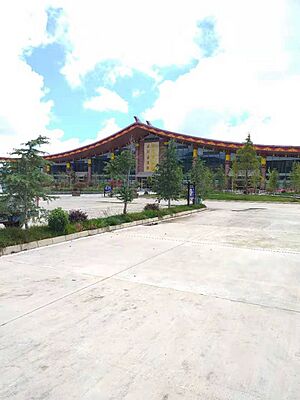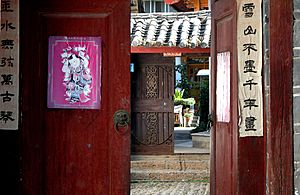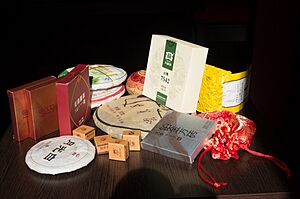Yunnan facts for kids
Quick facts for kids
Yunnan
云南
|
|
|---|---|
| Name transcription(s) | |
| • Chinese | 云南省 (Yúnnán Shěng) |
| • Nuosu | ꒊꆈ or ꒊꆈꌜ (Yypnuo or Yypnuose) |
| • Standard Zhuang | Yinznanz |
| • Abbreviation | YN / 滇 (Diān) or 云 (Yún) |
|
Meili Snow Mountains
Old Town of Lijiang
The Three Pagodas of Dali City
Honghe Hani Rice Terraces
|
|

Location of Yunnan in China
|
|
| Country | China |
| Kingdom of Nanzhao | 738 |
| Dachanghe | 902 |
| Ming conquest of Yunnan | 1381–1382 |
| Yunnan clique | 1915–1945 |
| Takeover by the People's Liberation Army | 1951 |
| Capital (and largest city) | Kunming |
| Divisions | 16 prefectures, 129 counties, 1565 townships |
| Government | |
| • Type | Province |
| • Body | Yunnan Provincial People's Congress |
| Area | |
| • Total | 394,000 km2 (152,000 sq mi) |
| Area rank | 8th |
| Highest elevation
(Kawagarbo)
|
6,740 m (22,110 ft) |
| Population | |
| • Total | 47,209,277 |
| • Rank | 12th |
| • Density | 119.82/km2 (310.3/sq mi) |
| • Density rank | 24th |
| Demographics | |
| • Ethnic groups | |
| • Languages and dialects |
|
| GDP | |
| • Total | CN¥3,002 billion (US$426 billion; 18th) |
| • Per capita | CN¥64,107 (US$9,097; 23rd) |
| ISO 3166 code | CN-YN |
| HDI (2022) | 0.729 (27th) – high |
| Yunnan | |||||||||||||||||||||||||||||||||||
|---|---|---|---|---|---|---|---|---|---|---|---|---|---|---|---|---|---|---|---|---|---|---|---|---|---|---|---|---|---|---|---|---|---|---|---|

"Yunnan" in simplified (top) and traditional (bottom) Chinese characters
|
|||||||||||||||||||||||||||||||||||
| Chinese name | |||||||||||||||||||||||||||||||||||
| Simplified Chinese | 云南 | ||||||||||||||||||||||||||||||||||
| Traditional Chinese | 雲南 | ||||||||||||||||||||||||||||||||||
| Literal meaning | "South of the colorful clouds"(彩雲之南 / 彩云之南) | ||||||||||||||||||||||||||||||||||
|
|||||||||||||||||||||||||||||||||||
| Yi name | |||||||||||||||||||||||||||||||||||
| Yi | ꒊꆈ yyp nuo |
||||||||||||||||||||||||||||||||||
| Tai Lue name | |||||||||||||||||||||||||||||||||||
| Tai Lue | ᦍᦲᧃᧉᦓᦱᧃᧉ jin naan |
||||||||||||||||||||||||||||||||||
| Lisu name | |||||||||||||||||||||||||||||||||||
| Lisu | ꓬꓱ-ꓠ ye na |
||||||||||||||||||||||||||||||||||
| Tibetan name | |||||||||||||||||||||||||||||||||||
| Tibetan | ཡུན་ནན་ yun nan |
||||||||||||||||||||||||||||||||||
| Northern Thai name | |||||||||||||||||||||||||||||||||||
| Northern Thai | ᩅᩥᩮᨵᩉᩁᩣ᩠ᨩ Witheharat |
||||||||||||||||||||||||||||||||||
| Thai name | |||||||||||||||||||||||||||||||||||
| Thai | มณฑลยูนนาน Mṇṯhl yū n nān |
||||||||||||||||||||||||||||||||||
| Vietnamese name | |||||||||||||||||||||||||||||||||||
| Vietnamese | Vân Nam 雲南 |
||||||||||||||||||||||||||||||||||
| Lao name | |||||||||||||||||||||||||||||||||||
| Lao | ຢຸນນານ yun nān |
||||||||||||||||||||||||||||||||||
| Burmese name | |||||||||||||||||||||||||||||||||||
| Burmese | ယူနန်ပြည်နယ် yunanpranynai |
||||||||||||||||||||||||||||||||||
| Shan name | |||||||||||||||||||||||||||||||||||
| Shan | ယူႇၼၢၼ်ႇ၊ မိူင်း yū⸒nān⸒, möṅː |
||||||||||||||||||||||||||||||||||
Yunnan is a province in Southwestern China. It's located inland, meaning it doesn't touch the sea. The province covers about 394,000 square kilometers and has a population of over 47 million people. Its capital city is Kunming.
Yunnan shares borders with Chinese provinces like Guizhou and Sichuan. It also borders the Tibet Autonomous Region. Plus, it touches countries in Southeast Asia: Myanmar, Vietnam, and Laos. Yunnan is known for its mountains, with high peaks in the northwest and lower areas in the southeast. Most people live in the eastern part of the province.
This region is very rich in natural resources. It has the most diverse plant life in China, with over 17,000 types of higher plants. Yunnan also has China's largest reserves of metals like aluminium, lead, zinc, and tin. It also has a lot of copper and nickel. Historically, an old trade route called the Southwestern Silk Road passed through Yunnan.
Parts of Yunnan were once the Dian Kingdom over 2,000 years ago. Later, the Han dynasty took control. After that, different kingdoms ruled, like Nanzhao and the Dali Kingdom. In the 13th century, the Mongol Empire conquered the area. Then, the Ming dynasty took over.
Over time, many people from other parts of China moved to Yunnan. This has made Yunnan one of China's most ethnically diverse provinces. About 34% of its people belong to ethnic minority groups. Some major groups include the Yi, Bai, Hani, Zhuang, Dai, and Miao. Yunnan is also believed to be where tea was first discovered.
Contents
What Does the Name "Yunnan" Mean?
The name "Yunnan" first appeared during the Han dynasty. It referred to a specific county near what is now Xiangyun County. Later, during the Tang dynasty, a powerful leader of the Nanzhao kingdom was called "King of Yunnan." As his kingdom grew, "Yunnan" became the name for the whole area. This is why the Yuan dynasty later created the Yunnan Province.
There are different ideas about what "Yunnan" means. One popular idea is "south of colorful clouds." Some old books from the Ming dynasty support this. However, some historians think this is just a simple guess based on the words. Another idea was "south of Yun Range" (Yunling Mountains). But this is unlikely because the name "Yunnan" is older than the name "Yunling Mountains." Modern experts have other theories, like it meaning "south of the mountain with clouds" or being a name from a local language like Loloish or Bai.
A Look at Yunnan's Past
Yunnan has a very long and interesting history.
Early Human History
The oldest human fossil found in China, called the Yuanmou Man, was discovered in Yunnan. This shows that people lived here a very long time ago. By the Neolithic period (New Stone Age), people had settled around Lake Dian. They used stone tools and built simple homes.
The Dian Kingdom
Around 300 BC, the central part of Yunnan was known as the Dian Kingdom. A general from the Chu state, named Zhuang Qiao, came into the region. He made himself the "King of Dian." His arrival brought Chinese culture and ideas to Yunnan.
Rule by Chinese Dynasties
In 221 BC, Qin Shi Huang united China and expanded his rule south. Later, in 109 BC, the Han dynasty conquered the Dian Kingdom. They set up a new area called the Yizhou Commandery. During this time, farming in Yunnan got much better. People used bronze tools and raised animals like cattle and horses.
During the Three Kingdoms period, China's central government became weaker. This meant Yunnan gained more independence. Local tribes had more power. In 225 AD, the famous leader Zhuge Liang led armies into Yunnan to bring peace to the tribes.
The Cuan Clan's Rule
In the 4th century, the Cuan clan moved into Yunnan. They ruled eastern Yunnan for over 400 years. During this time, trade routes passed through Yunnan. An old trade route connected Yunnan to Bengal through Burma. However, this route wasn't used much until later.
The Nanzhao Kingdom
Before the 8th century, many local tribes lived in Yunnan. Around Lake Erhai, six small kingdoms called zhao existed. The Mengshe zhao was in the south, so it was called Nanzhao, meaning "Southern Kingdom."
By the 730s, Nanzhao had united the area around Lake Erhai. In 738, Piluoge, the fourth king of Nanzhao, united western Yunnan. The Tang dynasty in China recognized him as king. The Nanzhao kings ruled from Dali City for over 200 years. They were important in the relationship between the Tang dynasty and the Tibetan Empire.
Nanzhao grew powerful and sometimes fought with Tang China. In 750, Nanzhao captured a large Tang settlement. Nanzhao then allied with the Tibetan Empire. This alliance led to big defeats for the Tang armies. By the end of the 8th century, Tang China was no longer a major threat to Nanzhao.
Nanzhao continued to expand. In 829, they attacked Sichuan and took many skilled workers back to Yunnan. They also attacked kingdoms in modern-day Burma and Cambodia. Nanzhao became a very strong kingdom in Southeast Asia.
However, Nanzhao's power eventually ended. In 902, a prime minister named Zheng Maisi killed the young king and started a new kingdom called Dachanghe.
The Dali Kingdom
In 937, Duan Siping took over and created the Dali Kingdom. This kingdom lasted until 1253 when the Mongol Empire conquered it. The Mongol prince appointed a governor to rule the region. After the Yuan dynasty fell, the Ming dynasty took control of Yunnan in the 1380s.
Ming and Qing Dynasties
During the Ming dynasty and Qing dynasty, many Han Chinese people moved to Yunnan. This migration made Yunnan even more diverse. A major conflict called the Panthay Rebellion happened in the 1800s. It involved Muslim Hui people and other minorities fighting against the Qing rulers.
Modern Yunnan
Yunnan changed a lot during the Second Sino-Japanese War (World War II). Many people and factories from China's east coast moved to Yunnan for safety. The Burma Road, a supply route from Burma to Kunming, became very important for China's war efforts.
During the war, a famous university, the National Southwest Associated University, was set up in Kunming. Students and teachers traveled a thousand miles to get there. Despite difficult conditions and bombings, this university produced many of China's top thinkers and scientists.
Yunnan's Amazing Geography
Yunnan is China's most southwestern province. The Tropic of Cancer crosses its southern part. The province covers about 394,100 square kilometers. Its northern part is part of the Yunnan–Guizhou Plateau.
Mountains and Rivers
Yunnan is mostly mountainous, especially in the north and west. High mountain ranges stretch across the province. There are deep canyons in the west and a plateau in the east. Yunnan's main rivers flow through these deep valleys.
The average height above sea level is 1,980 meters. Mountains in the north can reach over 5,000 meters. The highest point is Kawagebo Peak, which is about 6,740 meters high. The lowest point is in the Red River Valley, at 76.4 meters.
The eastern part of Yunnan has a limestone plateau with amazing karst scenery, like the famous Stone Forest. In this area, rivers generally flow east. The western part has mountains and rivers that run north and south. These include the Nu Jiang (Salween), the Lancang (Mekong), and the Jinsha (Yangtze). These three rivers flow very close to each other in a protected area called the Three Parallel Rivers. This rugged land creates a huge variety of plants and animals.
Climate
Yunnan has a mild climate with pleasant weather. This is because it's on south-facing mountain slopes and gets influences from both the Pacific and Indian oceans. Even though plants can grow for a long time, there isn't much flat land for farming. Most of the province has a subtropical highland or humid subtropical climate. Winters are cool to warm, and summers are mild. In the truly tropical south, temperatures often go above 30°C in the warmer months.
January temperatures usually range from 8°C to 17°C. July temperatures are typically between 21°C and 27°C. The province gets between 600 and 2,300 mm of rain each year, with most of it falling from June to August.
Lakes and Rivers
Yunnan has several large lakes. There are nine lakes with areas larger than 30 square kilometers. Some of these include:
- Dianchi Lake, near Kunming
- Fuxian Lake, the second deepest lake in China
- Erhai Lake, near Dali City
- Lugu Lake, near the border with Sichuan
Yunnan is also the source of two major rivers: the Xi River (starting as the Nanpan River) and the Yuan River. Six major river systems drain the province:
- The Yangtze River (called Jinsha Jiang here) in the north.
- The Pearl River, which starts near Qujing.
- The Mekong (Lancang), flowing from Tibet to the South China Sea.
- The Red River (Yuan or Honghe), flowing to Hanoi, Vietnam.
- The Salween (Nujiang), flowing into Burma.
- The Irrawaddy, which has small tributaries in western Yunnan.
Amazing Plants and Animals
Yunnan is China's most diverse province for living things. It has snow-capped mountains and tropical areas, supporting a huge variety of species. The Yunnan camellia is the province's special flower.
During summer, the Great Plateau of Tibet blocks monsoon winds. This traps moisture in Yunnan, making the alpine plants grow very lushly. This mix of land types and moisture leads to incredibly high biodiversity. Yunnan might have the richest plant life in the world's temperate regions. About 17,000 types of higher plants are found here, with around 2,500 found nowhere else.
Yunnan has less than 4% of China's land, but it's home to about 42.6% of all protected plant species in the country. It also has 72.5% of all protected wild animals. Many of these are found only in Yunnan. Famous animals include the gaur (a giant wild ox), the Indochinese tiger, and the Asian elephant. Very rare species like the Yunnan box turtle and the Yunnan snub-nosed monkey also live here. Sadly, the Yunnan lar gibbon might already be extinct.
Yunnan has 11 national and regional nature reserves, protecting about 510,000 hectares of land. The freshwater fish here are also very diverse, with about 620 species. Over 250 of these are found only in Yunnan, and many are in danger.
Natural Resources
Yunnan is very rich in mineral resources. Mining is a major industry here. The province has found 86 types of minerals in 2,700 places. About 13% of these are the largest deposits of their kind in China. Yunnan ranks first in China for deposits of zinc, lead, tin, cadmium, and indium. It also has large amounts of iron, coal, copper, gold, and silver. The total value of these minerals is estimated to be 3 trillion Chinese yuan.
Yunnan also has a lot of water. The rivers flowing through the province provide huge amounts of water, much more than the Yellow River. This means there's plenty of water for each person in the province. These rich water resources also provide a lot of hydro-energy (electricity from water). China is building dams on the Mekong River to use it for transportation and power.
Fun Places to Visit
Yunnan is a popular place for tourists because of its beautiful landscapes, mild weather, and diverse cultures. Most visitors are Chinese, but more and more foreign tourists are coming too.
National Parks
- Pudacuo National Park, opened in 2007, near Shangri-La County.
- Laojunshan National Park, near Lijiang.
UNESCO World Heritage Sites
Yunnan has several places recognized by UNESCO for their special cultural or natural importance:
- Old Town of Lijiang, a cultural site (1997).
- Three Parallel Rivers of Yunnan Protected Areas, a natural site (2003).
- South China Karst, a natural site (2007).
- Maotianshan Shales, a natural site (2012).
- Cultural Landscape of Honghe Hani Rice Terraces, a cultural site (2013).
Popular Tourist Spots
- Dali: An old city that was once the center of the Nanzhao and Dali kingdoms.
- Chuxiong: Home to the Yi ethnic group and their ancient town.
- Jinghong: The main city in the Xishuangbanna Dai minority area.
- Lijiang: A city of the Naxi minority, famous for its old town.
- Xamgyi'nyilha County (also called Shangri-La): A Tibetan town high in the mountains.
- Shilin (Stone Forest): Amazing limestone rock formations east of Kunming.
- Yuanyang: A Hani minority area with beautiful rice terraces on mountainsides.
- Xishuangbanna: A scenic area known for its nature and culture.
How Yunnan is Governed
Yunnan is divided into 16 main areas. These include 8 cities and 8 areas for different ethnic groups, called autonomous prefectures.
- Kunming city (the capital)
- Qujing city
- Yuxi city
- Baoshan city
- Zhaotong city
- Lijiang city
- Pu'er city
- Lincang city
- Chuxiong Yi Autonomous Prefecture
- Honghe Hani and Yi Autonomous Prefecture
- Wenshan Zhuang and Miao Autonomous Prefecture
- Xishuangbanna Dai Autonomous Prefecture
- Dali Bai Autonomous Prefecture
- Dehong Dai and Jingpo Autonomous Prefecture
- Nujiang Lisu Autonomous Prefecture
- Dêqên Tibetan Autonomous Prefecture
These 16 areas are then divided into 129 smaller areas, like districts and counties. As of 2021, Yunnan's total population was 48.01 million.
People and Cultures
Yunnan is famous for having many different ethnic groups. It has the most ethnic groups of any province in China. Out of China's 56 recognized ethnic groups, 25 are found in Yunnan. About 38% of the province's population belongs to these minority groups.
Some of the major ethnic groups include the Yi, Bai, Hani, Tai, Dai, Miao, Lisu, Hui, Lahu, Wa, Nakhi, Yao, and Tibetans. These groups live in different parts of the province, some in compact communities.
Languages Spoken
Most people in Yunnan speak dialects of Chinese that are similar to those in Sichuan and Guizhou provinces. These are part of the Mandarin group. Most people also speak Standard Chinese, which is used in schools and government.
Because of its many ethnic groups, Yunnan also has many different languages. These include Tibeto-Burman languages (like Bai, Yi, Hani), Tai languages (like Zhuang, Dai), and Hmong–Mien languages. The Naxi people use a special writing system called Dongba script. It's one of the only pictographic writing systems still used today. It was mainly used by priests for rituals and is now a tourist attraction.
Religions
Yunnan has a mix of religions. Many people practice traditional local religions, like Chinese folk religion among the Han Chinese. The Dai people often follow Theravada Buddhism. This makes Yunnan unique, as it's the only province in China where all three main types of Buddhism are widely practiced. Most of the Hui people in the region are Muslims. Christianity is common among the Lisu, Jingpo, and Derung ethnic groups.
-
Guishan Buddhist Temple of the Tibetan tradition.
-
Dai Theravada Buddhist temple in Menghai County, Xishuangbanna.
Farming and Food
Farming is still very important in Yunnan. Most farming happens in flat valleys, upland plains, and on terraced hillsides. There isn't much flat land for farming, so only about 5% of the province is used for crops. Rice is the main crop. Other important crops include corn, barley, wheat, sweet potatoes, soybeans, tea, sugarcane, and tobacco. In the western mountains, people raise livestock and cut timber.
Yunnan grows most of China's coffee. Large-scale coffee farming began here in 1988. The most common type of coffee grown is Catimor.
The province is also famous for its high-quality teas, especially Pu-erh tea. This tea is named after the old trading town of Pu-erh. Yunnan is also known for its black teas, like 'Dianhong', which means "Yunnan Red." These teas are grown high in the mountains.
Tobacco is a major product and a big part of Yunnan's economy. Yunnan also has a strong market for fruits and vegetables.
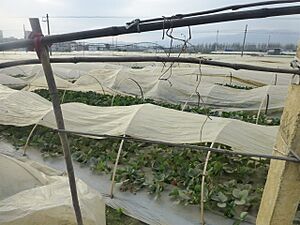
Yunnan is one of the best places in the world for wild mushrooms. Over 800 types of edible mushrooms can be found here. In 2004, about 7,744 tons of wild edible mushrooms were exported from Yunnan. The 'pine mushroom' is a main product and is exported to Japan.
The dairy industry in Yunnan is also growing quickly. It aims to export dairy products to nearby countries. The flower industry has also grown a lot since the late 1980s. Yunnan produces 50% of China's cut flowers. These flowers are sold in China and exported to countries like Japan, Korea, and Thailand.
Yunnan's Economy
Yunnan is one of China's less developed provinces. In 1994, about 7 million people lived below the poverty line. The government has worked to reduce poverty by investing in things like improving land, water, electricity, and roads.
Even though it's less developed, Yunnan has advantages because of its location. It's good for trade with Southeast Asian countries. The Mekong River (Lancang River) is a waterway to Southeast Asia. Roads have also been improved to boost trade with countries in the Greater Mekong Subregion.
Yunnan's main industries are agriculture, tobacco, mining, hydro-electric power, and tourism. The province still relies a lot on its natural resources. Manufacturing, like making iron, steel, and chemicals, is the largest part of Yunnan's economy.
A big challenge for Yunnan is its slower economic growth compared to other parts of China. It needs to improve its productivity and competitiveness. The province also faces challenges with protecting the environment and reducing poverty.
Yunnan trades with over 70 countries. It has a special trade zone with Myanmar in Ruili. Yunnan mainly exports tobacco, machinery, chemicals, farm products, and metals. In 2008, its total trade was US$9.6 billion.
Yunnan is a major producer of copper, lead, zinc, tin, and aluminum in China. Gejiu is known as "the Kingdom of Zinc" because it has the largest zinc reserves in the country. The electricity industry is also very important. Electricity from Yunnan is sent to other parts of China, especially Guangdong.
Education in Yunnan
Education in Yunnan has improved a lot since the 1960s. More people are getting higher levels of education. There are also many part-time schools and distance learning programs. These allow people to get an education while still working. Efforts are also made to teach adults who cannot read or write.
In higher education, Yunnan has one "National Key University" called Yunnan University in Kunming. There are also many technical schools, like Yunnan Normal University and Kunming Medical University. Other important learning places include the Yunnan Astronomical Observatory and the Yunnan Provincial Library. In 2000, Yunnan had 24 colleges and universities with over 90,400 students. Most children in Yunnan now attend primary school.
Getting Around Yunnan
Traveling in Yunnan can be challenging because of the mountains.
Railways
The first railway in Yunnan was built by France from 1904 to 1910. It connected Kunming with Vietnam. This railway helped Yunnan access the seaport at Haiphong. During World War II, a railway was started to connect Yunnan to Burma, but it was not finished.
Yunnan became connected to China's main railway network in 1966. Since then, more railway lines have been built within the province, connecting cities like Kunming, Yuxi, Dali, and Lijiang.
The province is also building railways to connect with neighboring countries in Southeast Asia. Lines are planned to link Yunnan with Vietnam, Myanmar, and Laos. These lines could eventually extend to Thailand, Malaysia, and Singapore.
Roads
Road construction in Yunnan has been very active. The province has added more new roads than almost any other province in China. Today, expressways connect Kunming to major cities like Dali, Baoshan, and Qujing. The goal is to connect all major towns and neighboring capitals with expressways by 2010, and to have a high-speed road network by 2020.
All county towns can now be reached by paved roads from Kunming. Most smaller towns have road connections. Yunnan has a network of roads that connect it to other Chinese provinces and to countries like Burma, Laos, Vietnam, and Thailand.
Airports
Yunnan has many domestic and international flight routes. From Kunming, you can fly to major cities across China and to international destinations like Bangkok, Singapore, Seoul, and Hanoi. There are also flights connecting Kunming to smaller cities within Yunnan.
The main airport is Kunming Changshui International Airport, which opened in 2012.
Bridges
Bridge building in Yunnan has a long history, going back over 1,300 years. Iron chain bridges were built over rivers like the Yangtze. The Jinlong Bridge in Lijiang is the oldest bridge over the Yangtze. As more roads and railways are built, many large bridges have been constructed across Yunnan's many rivers.
Metro
Kunming is the only city in Yunnan with a metro system. As of August 2021, it has 5 lines in operation.
Culture and Traditions
Yunnan has a very rich and diverse culture. Old burial sites have been found with beautiful bronze objects. Ancient paintings have also been discovered. For a long time, the local peoples lived in traditional ways. After the Cultural Revolution (1966–76), when some cultural practices were stopped, Yunnan began to celebrate its many cultures. Many local customs and festivals are now enjoyed.
Cuisine
Yunnan has its own unique style of cooking, known as Yunnan cuisine.
Tea
Yunnan is famous for its teas. One of the most well-known is Pu-erh tea, named after the town of Pu-erh. The province is also known for its black teas, like Dianhong, which means "Yunnan Red."
Traditional Chinese Medicine
Yunnan is home to over 19,000 types of plants. About 60% of the plants used in traditional Chinese medicine come from Yunnan. A famous medicine from here is Yunnan Baiyao.
See also
 In Spanish: Yunnan para niños
In Spanish: Yunnan para niños


